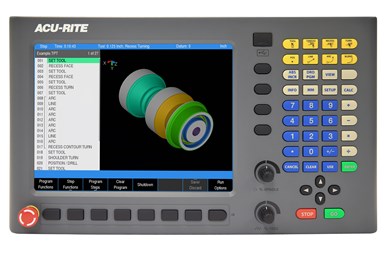Acu-Rite TurnPwr Control Enables Manual, Automated Lathe Operations
It enables users to maximize throughput by significantly reducing setup time, scrap and other nonproductive operations, thereby increasing efficiency, productivity and profitability.

Acu-Rite TurnPwr Control
Acu-Rite’s TurnPwr control is a workshop-oriented turning control for lathes that enables users to program conventional machining operations right at the machine in an intuitive conversational programming language. It is designed for lathes with up to two axes.
TurnPwr was developed to offer lathe machinists both manual and automated operation where useful or needed. It enables users to maximize throughput by significantly reducing setup time, scrap and other nonproductive operations, thereby increasing efficiency, productivity and profitability.
The company says that the Acu-Rite conversational programming format for controls is a user-friendly method of writing part programs and included in the TurnPwr. However, G-code (ISO) programming can also be used and basic editing of G-code programs is also possible.
The control features a 12.1" high-resolution display boasting a screen layout that is clearly arranged. Preview graphics in the editor illustrate the individual machining steps for programming the contour as well as corresponding tool path generated, using only dimensions pulled from a production drawing. It also accepts DXF files.
TurnPwr is a closed-loop system with positioning feedback provided by rotary encoders inside the motor assemblies. When fitted with the (optional) Acu-Rite precision glass scales (1 µm/0.00005" resolution), TurnPwr also includes Position-Trac, an advanced feature that enables the user to easily, quickly and accurately reestablish workpiece zero after shutting down or power loss.
Related Content
-
Precision Machining Technology Review October 2023
Production Machining’s October 2023 technology showcase includes some of the latest technology from Tungaloy-NTK America Inc., Renishaw, Walter USA, Seco Tools and Haimer USA.
-
Keeping Watch on Small Parts
From watch parts to exotic medical applications, this shop takes on the world of micromachining.
-
What Is Trochoidal Turning? How Might Shops Benefit From It?
While trochoidal milling might be a more well-known toolpath strategy, trochoidal turning can offer similar benefits such as high material removal rates especially for rough-turning operations.









.jpg;maxWidth=300;quality=90)






